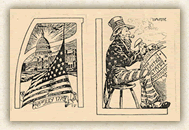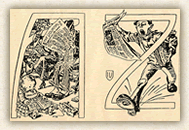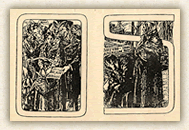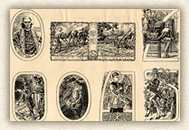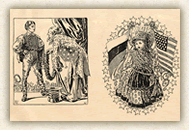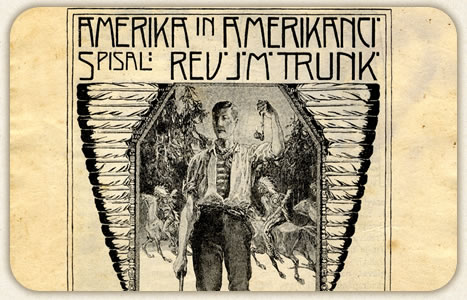|
A large part of the book is dedicated to the history of the United States. Let us take a look at some of Vavpotič’s motifs from the American history (from left to right): acceptance of the declaration of independence (July 4th 1776) / Uncle Sam is driving a nail in the barrel of the American constitution (1787) / Abraham Lincoln (abolished slavery, 1865) / struggle for the emancipation of women / a proud American native / a humorous illustration of a New York skyscraper with angels in clouds.
|
|
America was a country with developed traffic and industry, where the logics of capital and work were intertwined. The social and anti-capitalist points are obvious in the last two illustrations. |
|
Uncle Sam, as an allegory of America, is turning the globe. The United States became a world economic power in the 19th century. The payment for work was better than in the emigrant countries, yet it was hardly earned. |
|
America was a country of media and last but not least of sports. |
|
|
The journey of Slovenes to America: the cunning agents are suggesting the way to New York through Hamburg / with the shipping company Austro-Americana they travelled through Trieste / by steamship across the Atlantic / an ironic illustration of "dollars floating in the air". |
|
A short history of Slovenes in the United States (from left to right): Slovene missionary Friderik Baraga (arrived in 1830) / a comparison of working in fields in the time of the fathers in 1865 (with horses) and in the time of the sons in 1912 (with machines) / accordionist in his spare time / work in a mine / work by a machine / a Slovene Catholic acolyte / Americanisation: behind uncle Sam a procession follows in different Slovene national costumes. |
|
American Uncle Sam is bowing and offering a laurel garland to a young Slovene man on the American stage. Who was the winner here? The young man who gained work and thus improved his life, or the American employer who was in need of his diligent hands and bright head for work in factories and mines? Nevertheless: Girl, dressed in a national costume, holding an American flag in her left and “Carniolian” in her right hand, concludes the book with an appeal to American-Slovene friendship. |
|
|
|

